The Bagpipe Society
Bagpipes in Austria - A Story of Diversity
Austria is known throughout the world mostly for the music of Wolfgang A. Mozart, “Silent Night” and “The Sound of Music” (although I have to reveal at this point that hardly anyone has seen the film here). Little is it known to most bagpipers in the world that Austria, too, has had and continues to have a story of piping, and an interesting one at that. The Austria the world knows today is actually a quite young country and consists of only a small part of what was once the Habsburg Empire (which throughout history was commonly labelled as “Austria”) and thus part of the greater Holy Roman Empire. It is of eminent importance to bear this in mind, since most of the bagpipe’s history in this region features a constant flow of cultures from West to East and North to South, and Austria never was home to only one nation with one language, but always a meeting point of diverse peoples, tongues and cultures. Therefore, the beginnings of piping in Austria cannot be investigated in seclusion from neighbouring cultures and regions.
The first clear reference to bagpiping in modern-day German-speaking lands comes from the mid 9th century encyclopaedia “De Universo” by Rabanus, abbot and bishop of Fulda. In a list of musical instruments mentioned in the bible, he links the name “chorus” to a sort of bagpipe, saying that “chorus, too, is a simple hide with two tubes, and through the first air is blown in, through the second the voice emerges”. Likewise, the instrument “tympanum” is first described as a drum, but then as “a sort of trumpet”; this awkward description may be due to a mistake in the original copy. However, early on Rabanus’ text was also circulated as “Letter of St. Jerome”, and at least one contemporary illustration from France shows that the illuminator understood both “chorus” and “tympanum” as bagpipes. The psaltery of Angers clearly shows them as bagpipes; the tympanum even has an animal’s head there. Scribbled around the instrument are Latin lines reading “The tympanum is an inflated cat skin with two pipes in the legs and one in the neck”; it should be noted here that both names, “chorus” and “tympanum”, were never used to denote bagpipes in ancient Latin or in any Romance vernacular, but are rather to be viewed as scholarly interpretations (and faulty ones at that) of little-understood terms.
A nice archaeological counterpart to these sources is a double pipe made of crane bones uncovered in Jánoshida, Hungary. The pipe was found in a grave of an Avarian man and predates Rabanus’ text by about 200 years. However, it is a good example of what Pannonian reed instruments looked like in the early Middle ages. It seems that the two tubes formed a parallel double pipe with single reeds, like they are used today in that very region. Simple reed instruments with single reeds were obviously common all over Europe during the Middle ages, as numerous specimens dating from the 10th to the 14th century, unearthed mostly in Germany and France, clearly show. The modern Welsh pibgorn and the Basque alboka, among many others, are obvious remnants of this tradition.

By the late Middle ages, a European standard of a one-drone bagpipe with single chanter emerged, probably originating in Spain. This type of bagpipe might have originally been an invention oriented towards copying the sound of shawm and trumpet bands which were and are still today common in Northern Africa. Such bands have shawms playing the tune and straight trumpets to add a drone; the similarity of Medieval depictions of such bands to their modern-day appearance in Algeria and Morocco is striking. Anthony Baines first imagined a linkage between this originally Moorish custom and the appearance of a single-drone bagpipe; if this be true, the very invention of the bagpipe as we know it today must have taken place in the 13th century. Before that, as I would like to show another time, linguistic evidence shows that all terms for “bagpipe” really denoted any kind of reed instrument, whether played in the mouth or by means of a bag. Thus, playing pipes with a bag was simply a comfortable option for the player, but the process itself did not create a new instrument. This only changed when the form and number of pipes was altered to a point where they could not simply be taken from the bag and played orally any longer. Well after that, we still see in today’s English that “the pipes” suffices for a bagpipe.
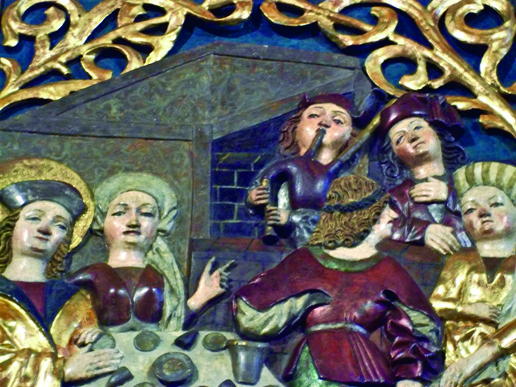
Single drone bagpipes appear in German iconography in the late Middle ages, as does the term “sackpfîfe”, literally meaning “bagpipe” (“Sackpfeife” in Modern German). Throughout the 15 century, bagpipes seem to follow a rather uniform European style. The Gothic altar of the church of Morzg near Salzburg, made in 1480, shows such a bagpipe. It is difficult to judge whether the chanters of these bagpipes used single reeds and cylindrical bore or double reeds and conical bore. A chanter found in the North German town of Rostock, originating around 1400, clearly was meant to have a single reed, but that might not have been the general case. It might be safe to argue that there were local discrepancies in terms of reed types. Likewise, the scale of these instruments remains uncertain. The Rostock chanter features a scale of a seventh plus leading note, with a neutral third and sixth to leave the final choice of tuning to the destined owner. Since no piece of music specifically meant to be played on bagpipes has been found until now, we might argue that, while regional standards definitely existed, much of the tuning of the instrument was left to the player.
By the 16 century two-drone bagpipes became popular in the Holy Roman Empire, which covered most of today’s Netherlands, Germany, Czech Republic and Austria. The most detailed description of such an instrument is given by Praetorius, Michael in 1619, who writes that the “shepherd bagpipe” (“Schaperpfeiff”) has two drones sounding Bb and f as well as a chanter with a span from e’ to f’’. He mentions that the instruments had no thumb hole, so the highest note f’’ of the given scale (and further possible notes which were not documented by him) was overblown. In order to achieve a pure octave (or fifth in regard to the center on bb’) the index finger hole had to be placed higher, thus the penultimate note; the fourth in regards to the drone-indicated tonality of Bb — was too high. Praetorius is quite clear that the note produced is “wrong”. An instrument reflecting many of the characteristics of Praetorius’ shepherd bagpipe has survived in the collection of the Hofburg Museum in Vienna — it is the only surviving specimen of a German bagpipe. Replicas of this instrument have shown that it features exactly what Praetorius describes: a sharp fourth in order to gain a perfect fifth via overblowing. However, the instrument clearly was made by a talented craftsman, so it seems strange that the holes simply were spaced in the wrong manner or that the makers didn’t think of the simple alternative of drilling a thumb hole. It is very clear to my opinion that they wanted the instruments to sound exactly as they did, with notes outside of an ordinary scale — in fact, this sharp fourth is nothing but the 11 partial tone of the overtone sequence, and is well documented in early folk music sources in Austria. This note was commonly heard on trumpets, horns, Jew’s harps and other instruments which made use of the overtone scale, so it does not seem farfetched to assume that bagpipes featured it, too.
Instruments similar to the Vienna specimen are well documented by countless depictions in art throughout Germany and Austria — I would like to remind once more that the borders we know today had no meaning in those days, as national states did not exist (likewise, Mozart viewed himself as a German composer, coming from the then sovereign church principality of Salzburg, which in turn was seen as a Bavarian town). Therefore, the bagpipes shown in paintings, carvings and potteries show a great unison from Swabia to East Austria. Until the mid18 century these two-drone bagpipes continued to be in regular use, commonly referred to as called “Sackpfeife”. The last use of this kind of instrument is documented for Swabia, where it was used for the annual shepherd feast.
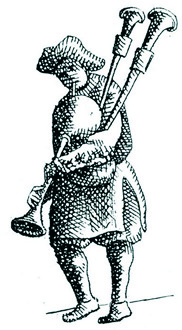
The original instrument was lost at an unknown point after 1900 and was replaced with a set of Scottish Highland bagpipes. In Austria, the last depiction of this kind of instrument comes from the 1780s, at which time the two-drone bagpipes were already scarcely used. Since the almost total lack of original instruments, it is hard to tell whether the similarities between the instrument described by Praetorius and the Vienna specimen can give us valuable information about how common these features were. Praetorius was located in Middle Germany and with “Schaperpfeiff” clearly gives a Low German variant of the Standard “Sch‰ferpfeife”; the Vienna instrument in turn seems to show a Flamish style of crafting. Southern depictions mostly feature two-drone bagpipes with somewhat shorter and more shawm-like drones, regularly equipped with what looks like the typical key bulbs of Renaissance shawms — it is altogether possible that indeed shawms were used as drones, as they are with the zampogna in Southern Italy. However, the absence of both historical instruments and music specifically written for this type of bagpipe leaves all details to speculation.
Much like Austria, the German country of Saxony is located at crossroads between Slavic and Germanic cultures. It is precisely there were we are to find the origins of another type of bagpipe which played a large part in early German and Austrian folk music. Praetorius, Michael mentions it under the name “Bock”, meaning “buck, billy-goat”, a large, low-sounding, fully single-reed bagpipe with cow horn resonators, genuinely Slavic in style. It might have been the French influence during the early Baroque which yielded this instruments’ transformation from a peasant bagpipe into a refined musical instrument used at court. Equipped with bellows, a cross section bending the long drone downwards and a drone shortening section, it was known throughout the 17 and 18 century as “Polnischer Bock”, the Polish buck. A low-pitched instrument with a chanter range from the dominant to the sixth (e. g. a to b’ for a D major instrument, with b often missing) and a drone sounding two octaves beneath the tonic, it was often crafted in a grotesque manner: The stuffed hides of whole goats were used to cover the leather bags, whereby the head would serve as a chanter stock. Tsar Peter the Great, a passionate piper himself, is known to have had his pet bear made into a Polish bagpipe after its death. It is this very instrument that survives today in the kozioł of Poland, the kozol of the Sorbs of Saxony and the dudy of Bohemia, a remnant of the Baroque and Rokoko style of artificial peasantry at the courts of the Holy Roman Empire. The duke of W¸rttemberg was only one of the many princes and rulers to employ a “Bockpfeifer” band. One of his employees, one Mr. Georg Wilhelm Weissmann, listed as fiddle player among the pipe band in the 1730s, is thought to be identical with the Mr. Weissmann who composed a pastorella for chamber orchestra and bagpipe — the manuscript was preserved in Bohemia and is the earliest existing source for Central European bagpipe music. Another one, and a prominent one at that, is the “Peasant Wedding” written by Leopold Mozart around 1755/1756. In this piece, the rural flair is provided by the use of the hurdy gurdy. 30
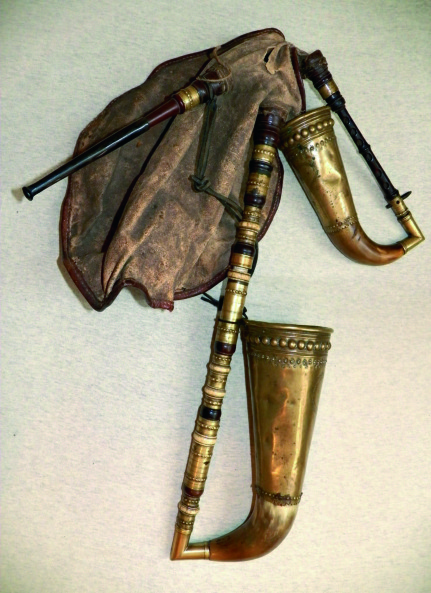
Mozart’s piece is an interesting source in many ways — not only does it show what might be actual folk repertoire crafted into a piece of classical music, it also provides us with a variant of the name now commonly used for the bagpipe in German, “Dudelsack”. This term, documented in German since the 17 century, was exclusively used for instruments of the kind of Polnischer Bock, never for the two-drone shepherd bagpipe. It was obviously labelled after Czech and Polish “dudy”; the Bohemian dudy of this time was a high-pitched and mouth-blown type of the Bock family with a straight drone, commonly crafted with horn bells but without further zoomorphic features. It showed the same musical possibilities as the larger instrument, although sounding one octave above it. Mozart asks for a “Polnischer Bock” OR a “Dudsack”, the music is noted in a high register — this likely means that he was talking about two different, albeit similar instruments. Together with other the accounts of the writers Johann Beer and Karl Ditters von Dittersdorf, we see that in the 18 century three types of bagpipes were used in what today is Austria: The older Sackpfeife with oboe chanter and two drones, the Polnischer Bock with one drone and single reeds in both drone and chanter, and the high-pitched Dudelsack sharing the same musical abilities. In Bavaria and Austria, a more slender type of the Polnischer Bock emerged in the 18 century, which used a square-shaped, triple-bored shortening section for the drone and replaced the grotesque features with a more elegant style. The head was now commonly made of wood and less realistic in shape and size. The chanter had lost the hole for the little finger by then, since the sixth below the tonic (b on a D instrument) was never used.
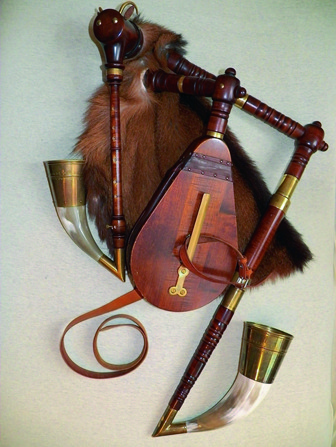
By the turn to the 19th century, the declining piping tradition in German-speaking areas almost exclusively used this instrument and called it “Dudelsack” — the former trichotomy of instruments and terms had all but vanished then. In Bohemia, the instrument gradually replaced the high-pitched dudy of the Czechs over the course of the 19 century, but only fully took its place after 1900. The last accounts of pipers in today’s Austria come from the first half of the 19 century, with one notable and somewhat unclear exception of a Styrian watchman, who is said to have still played his pipes around 1900. However, these were not the last Austrian or German pipers in general: Aside from the thin piping tradition in Swabia, the Germans of Egerland in Bohemia (belonging to Austria until 1918) kept their piping tradition vividly present until their expulsion from Czechoslovakia in 1946. They mostly used high-pitched instruments in Bb or Eb of the older Dudelsack type, together with fiddles and clarinets. Low-pitched instruments were also used, but were less common. After the forced resettlement, most pipers did not continue their tradition in their new homes in Germany, since the rural piping was not suitable for the big cities anymore. When the interest in piping in Germany grew again in the 1970s, the line of tradition to the Egerland pipers had been broken for almost twenty years. Little did the new pipers know then, that indeed a German/Austrian piping tradition continues to exist with no interruption in the New Zealand community of Puhoi, which was founded by Bohemians in the 1860s. Although the German language has mostly vanished, the interest in Bohemian piping is still going strong there.
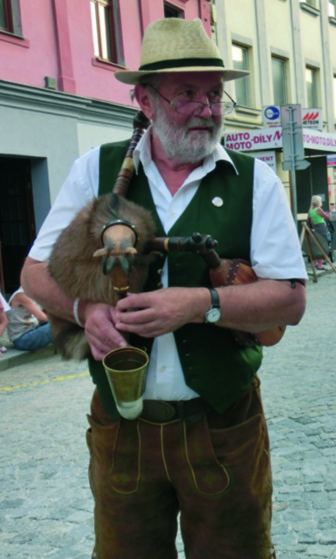
In Austria, the renaissance of piping started with one man, Rudolf Lughofer. Having bought a vinyl disc of a Bohemian bagpipe band in the 1960s, he bought an instrument in Prague and through the Cold War repeatedly managed to go to Czechoslovakia to learn how to play it. When he discovered that this very instrument was originally also played in Austria, he started a band together with a colleague playing the hurdy-gurdy. Over the course of the 80s and 90s, the slowly growing scene evolved into a prosperous one, with several seminars all through the year.
Soon, the growing influence of French folk music, which can be seen in Germany as well, lead to the use of French bagpipes and reconstructions of the shepherd bagpipes of old — indeed, the situation of piping today much resembles the plurality of the early 18 century. Western piping tradition meets the Eastern one here, as it did centuries ago. Of the several hundred people who have learned how to play the pipes during the last twenty years, some have indeed evolved into active and virtuoso pipers. Aside from Rudolf Lughofer, Sepp Pichler from Styria and Albin Paulus from Vienna should be mentioned. I myself started off with Highland Pipes at age 9 in 1995, before discovering the rich tradition lying in front of my doorstep; today, I work as a professional musician with several ensembles and as a piping teacher. Additionally, I have made the pipes the topic of my scientific research as a linguist. The bagpipe today has become a minor, but stable factor in Austrian folklore again, and it continues to attract both young and old people. It might be that the controversial richness of being limited to a drone and just oh so few notes, but yet being able to make the most wonderful music with these few colours is a major contributing factor.
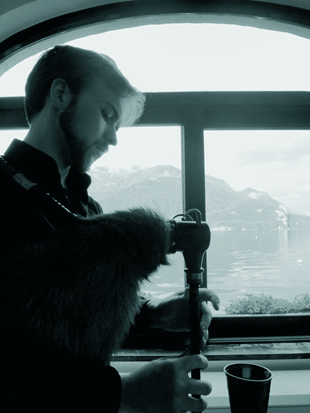
Michael Vereno has been a piper since 1995. Aside from his working field as a historical linguist, he regularly plays the pipes in various ensembles and as a soloist. He is happy to answer questions concerning further details of this article’s topic.
By Praetorius, Michael Trad Various Vereno, Michael Peter
From Chanter Summer 2016.
- Data Processing Notice (GDPR)
-
@BagpipeSociety on X (formally known as Twitter)
-
TheBagpipeSociety on Instagram
-
 BagpipeSociety on Facebook
BagpipeSociety on Facebook
Something wrong or missing from this page? Let us know!
